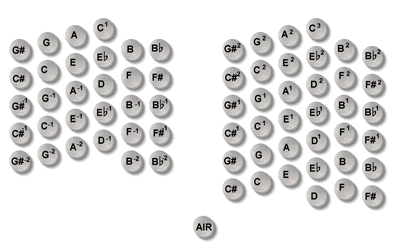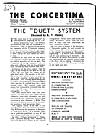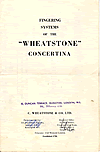Late Wheatstone Chidley System Duet Concertina |
|
|
|
Late Wheatstone Chidley System Duet ConcertinaDirectoryKenneth Vernon Chidley (1892-1964), was a son of Edward Chidley junior (1858-1941), and grandson of Edward Chidley senior (1830-1899) both associated with Wheatstone & Co. going back to the days of Professor Wheatstone (dates and genealogy from Wes Williams's unpublished research). K. V. Chidley said that he entered the family business in 1906, and managed production from 1924. He was a director of C. Wheatstone & Co. in the mid twentieth century, and is recorded as experimenting with new fingering for duets before World War II. At the end of 1950, when Wheatstone was just emerging from its hibernation of 1939-1949, an article written by him appeared in "The Concertina," a section in the World Accordion Review, of which Chidley was at the time the Technical Advisor. In the article, he described a new fingering system for Wheatstone duets (the "Chidley system"). Like the Maccann system, his design had six columns, but with each column containing a strict alternation of exactly two notes of the twelve-note scale (for example, column 3 on the right side contained the notes a, e’, a’, e’’, a’’, e’’’, a’’’ ). To a Maccann player this resembles the Maccann arrangement with all the "irregularities" removed, and so Chidley-system instruments are now often referred to as "Chidley-Variant Maccanns" (and they did replace the Maccann-system instruments in the Wheatstone catalog). But Chidley’s discussion in this article suggests that his thought process was not to modify the Maccann design, but to go back to earlier Wheatstone designs and to extend them in a better way than Maccann had done. Chidley particularly singles out for mention William Wheatstone’s otherwise-obscure seven-column design from the patent of 1861 (and from the unique instrument #35074, though unmentioned), and he adopts a feature seen in #35074, the deeper overlap of one and a half octaves between the two sides. This new fingering system in fact began to be manufactured by Wheatstone just a few months later. In the Wheatstone production ledgers, instruments with the Chidley-system fingering are identified as "uniform keyboard" or "uniform fingering." The first such instrument was #35736, completed 3 April 1951. But Wheatstone was making few duets in the 1950s, and some of those were Maccann-system instruments requested by purchasers; it seems likely that fewer than 50 Chidley-system duets were ever made, all between 1951 and 1966. Robert Gaskins
|

Entry in Wheatstone & Co.
Production Ledgers for the earliest Chidley System Duet found, 72-key Ebony No. 35736 completed 03 April 1951 Contents
|
Send this page to a friend.
This page was last changed | |
|
© Copyright 2000– by Robert Gaskins |




